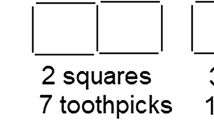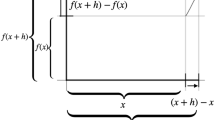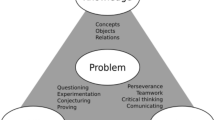Abstract
The article describes mathematicians’ pedagogical perspectives on proof in the teaching of first year university students at a mathematics department in Sweden. A conceptual frame that was used in the data analysis combines theories about proof from earlier mathematics education research with a social practice approach of Lave and Wenger. A theoretical idealised model of three different teacher styles was constructed from the data that consist of transcripts of interviews with 13 mathematicians at the department. The model gives structure to the results and can be applied and developed when comparing teaching cultures between different departments in a country as well as between different countries.

Similar content being viewed by others
References
Alibert, D. (1988). Towards new customs in the classroom. For the Learning of Mathematics, 8(2), 31–43.
Bell, A. W. (1976). A study of pupils’ proof — explanations in mathematical situations. Educational Studies in Mathematics, 7, 23–40.
Brandell, G., Hemmi, K., & Thunberg, H. (2008). The widening gap — A Swedish perspective. Mathematics Education Research Journal. The Special Issue on the Transition from School to University Mathematics. 20(2): 38–56.
Chin, E.-T., & Tall, D. (2000). Making, having and compressing formal mathematical concepts. In T. Nakahara and M. Koyama (Eds.), Proceedings of the 24th Conference of the International Group for the Psychology of Mathematics Education, 2, 177–184. Hiroshima, Japan.
de Villiers, M. (1986). The role of axiomatisation in mathematics and mathematics teaching. Stellenbosch: University of Stellenbosch.
de Villiers, M. (1990). The role and function of proof in mathematics. Pythagoras, South Africa, 23, 17–24.
de Villiers, M. (1991). Pupils' need for conviction and explanation within the context of geometry. Pythagoras, South Africa, 26, 18–27.
Edwards, D., & Mercer, N. (1987). Common knowledge. The development of understanding in the classroom. London: Routledge.
Fischbein, E. (1987). Intuition in science and mathematics. Boston, MA: Kluwer.
Hanna, G. (2000). Proof, explanation and exploration: An overview. Educational Studies in Mathematics, 44, 5–23.
Hanna, G., & Barbeau, E. (2008). Proofs as bearers of mathematical knowledge. ZDM — The International Journal on Mathematics Education. The Special Issue on Proof. 40: 345–353
Harel, G. (1998). Two dual assertions: The first on learning and the second on teaching (or vice versa). American Mathematical Monthly, 105(6), 497–507.
Hemmi, K. (2006). Approaching proof in a community of mathematical practice. Doctoral thesis (monograph). Stockholm University, Department of Mathematics, Stockholm.
Hemmi, K. (2008). Students’ encounter with proof — The condition of transparency. ZDM — The International Journal on Mathematics Education. The Special Issue on Proof. 40: 413–426
Hemmi, K. (2010). A theoretical framework for the study of proof in mathematics education. In B. Sriraman, C. Bergsten, S. Goodchild, G. Palsdottir, B. D. Søndergaard, & L. Haapasalo (Eds.), The sourcebook on Nordic research in mathematics education. Charlotte, NC: Information Age.
Hemmi, K., & Löfwall, C. (2009). Why do we need proof? A paper presented at CERME 6 - Sixth Conference of European Research in Mathematics Education (Jan 28th - Feb 1st, 2009), Lyon, France.
Hersh, R. (1993). Proving is convincing and explaining. Educational Studies in Mathematics, 24, 389–399.
Lakatos, I. (1976). Proofs and refutations. Cambridge, UK: Cambridge University Press.
Lave, J., & Wenger, E. (1991). Situated learning: Legitimate peripheral participation. Cambridge, UK: Cambridge University Press.
Lerman, S. (2000). Some problems of socio-cultural research in mathematics teaching and learning. Nordic Studies in Mathematics Education, 8(3).
Moore, R. (1994). Making the transition to formal proof. Educational Studies in Mathematics, 27, 249–266.
Nordström (Hemmi), K. (2004). A pilot study on five mathematicians’ pedagogical views on proof. A paper presented at ICME 10, Denmark, Copenhagen, 2004. Retrieved September 12, 2006 from http://www2.math.su.se/∼kirsti/icmepaper040507.doc
Nordström (Hemmi), K., & Löfwall, C. (2006). Proof in Swedish upper secondary school mathematics textbooks — the issue of transparency. In M. Bosch (Ed.), European research in mathematics education IV. Proceedings of CERME4, San Feliu de Guíxols, Spain 2005 (pp. 448–457). Barcelona: Universitat Ramon Llull.
Säljö, R. (2005). Cultural tools and human knowing: A sociocultural perspective on learning and the study of learning. Lecture. NoGSME (Nordic Graduate School in Mathematics Education) Summer school. Jyväskylä, Finland.
Schalkwijk, L. V., Bergen, T., & Rooij, A. V. (2001). Learning to prove by investigations. Educational Studies in Mathematics, 43, 293–311.
Sfard, A. (1991). On the dual nature of mathematical conceptions: Reflections and processes and objects as different sides of the same coin. Educational Studies in Mathematics, 22, 1–36.
Viholainen, A. (2008). Prospective mathematics teacher’s informal and formal reasoning about the concepts of derivative and differentiability (Doctoral thesis). Jyväskylä: Faculty of Mathematics and Science, Jyväskylä University.
Wartofsky, M. W. (1979). Models: Representation and the scientific understanding. Dordrecht: D. Reidel.
Weber, K. (2002). Beyond proving and explaining: Proofs that justify the use of definitions and axiomatic structures and proofs that illustrate technique. For the Learning of Mathematics, 22(3), 14–17.
Wellington, J. (2000). Educational research: Contemporary issues and practical approaches. London: Continuum.
Wenger, E. (1998). Communities of practice. Cambridge, UK: Cambridge University Press.
Acknowledgement
The article was written with help of the financial support of The Bank of Sweden Tercentenary Foundation. I thank the anonymous reviewers for their valuable comments and suggestions.
Author information
Authors and Affiliations
Corresponding author
Appendix 1. Mathematics, basic course (30 ECTS credits)
Appendix 1. Mathematics, basic course (30 ECTS credits)
Course description:
Introductory course (7.5 ECTS credits).
Polynomial division, the factor theorem, factorisations, inequalities, absolute value, geometric sum, functions, the straight line, power functions, exponential and logarithmic functions, geometry (congruence and similarity), trigonometry, trigonometric functions. Somewhat about sets. Complex numbers.
Linear algebra (7.5 ECTS credits).
The binomial theorem, proof by induction.
Systems of linear equations, matrix algebra, determinants, vectors in 2 and 3 dimensions, linear independence, dot product, vector product, straight lines and planes, linear mappings.
Mathematical Analysis 1, (7.5 ECTS credits).
Inverse functions, cyclometric functions.
Limits, continuity, derivatives, derivation rules, derivation of elementary functions, extreme value problems, asymptotes, inequlities, integrals, relation between primitive functions and integrals, partial integration, method of substitution, integrals of certain classes of functions.
Mathematical Analysis 2, (7.5 ECTS credits).
Functions of one variable:
Applications of integrals. Differential equations (separable, linear first- and second-order equations), Taylor’s formula.
Functions of several variables: Limits, partial derivation, level curves and level surfaces, tangent plane, linear approximation, extreme value problems over compact domains, double integrals.
Teaching and learning methods:
Lectures: 8 h/wk.
Lessons in small groups: 7 h/wk.
Methods of assessment: Written examination in each of the four sub-courses of 7.5 ECTS credits.
Rights and permissions
About this article
Cite this article
Hemmi, K. Three styles characterising mathematicians’ pedagogical perspectives on proof. Educ Stud Math 75, 271–291 (2010). https://doi.org/10.1007/s10649-010-9256-3
Published:
Issue Date:
DOI: https://doi.org/10.1007/s10649-010-9256-3




